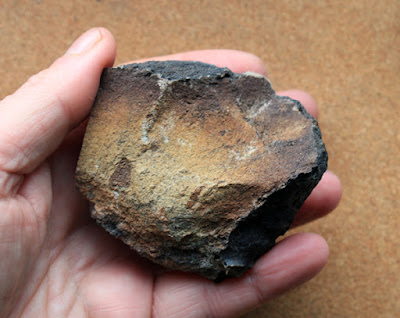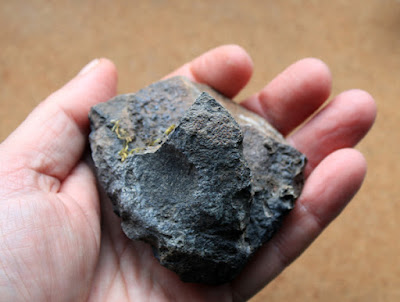 |
| A specimen of sandstone from the rampart of Wincobank Hillfort |
Leaving Posh and Pillar and her Daughters at the summit of Jenkin Hill, I passed through the entrance to Wincobank Hill and immediately came across Wood Lane, a track partly covered in large sandstone setts that once led to the now demolished Wincobank House – a tower house built by George Parkin between 1887 and 1907.
I didn’t get down on my knees to look at the sandstone with my hand lens but, looking at its general colour and texture, this is probably derived from one of the quarries that once operated beneath the ridge of Silkstone Rock, upon which the fort is set.
Looking at the geological map and old Ordnance Survey maps, it is probably the Parkgate Rock and associated strata that were being quarried here, but I have not yet explored this area or found any documents to confirm this.
Further along the path, I noticed a stretch of Wood Lane where the sandstone setts were mixed in with a completely different stone. Again, I didn’t examine them closely but I think that they are a fine grained intrusive and basic igneous rock – just one of the ‘granites’ in the British Islands that were commonly used to build roads.
Arriving at the entrance to Wincobank Hillfort, which is dated to c.500 BC and is described in the Scheduled Monuments listing as univallate, I followed the southern rampart and was very interested to soon discover a large piece of what looks like black slag on the side of the path.
I saw more smaller fragments along the path, which had been exposed by the weather and wear along the path over the years. When I removed a small loose piece, I was very surprised to see that the black slag appears to have been fused to a lump of fine grained sandstone.
According to the Wincobank Living History website, iron slag has been found in the vicinity of the hillfort and a geophysical survey suggests that ironworking may have occurred within the fort itself, which I thought may have explained the presence of slag in the rampart; however, archaeological investigations have shown that a large proportion of the rampart has been subjected to immense heat and vitrified to varying degrees.
The rampart originally consisted of a stone faced rubble core, which was reinforced with timbers, but I didn’t spend any time investigating it further and, after briefly stopping to take in the panoramic views, I continued along the path towards Wincobank Wood.








No comments:
Post a Comment